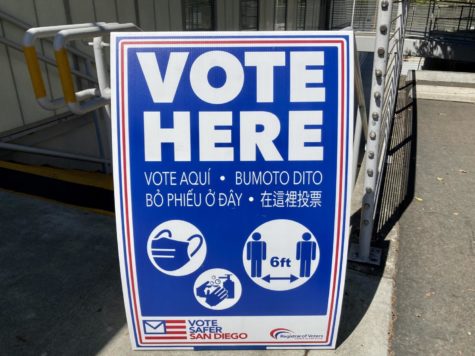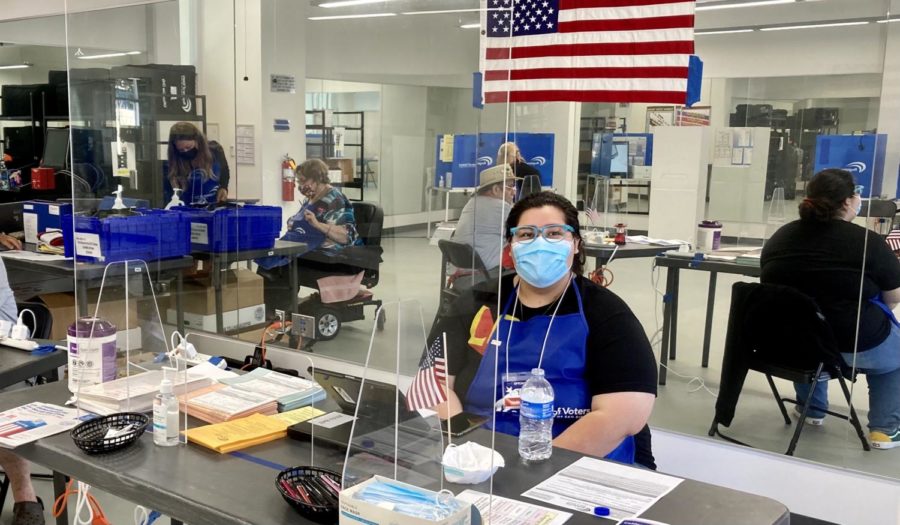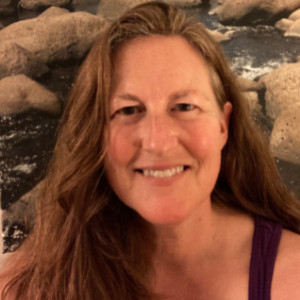Will City College students vote in the recall election?
City students share their experiences and thoughts on the upcoming election
City College student and poll worker Yulyssah Marin greets voters at the voting location next door to Harry West Gym. Photo by Kathy Archibald/City Times Media
September 13, 2021
San Diego City College student Yulyssah Marin said she started voting at age 18.
“I remember going to the polls with my mom,” she said.
The 20-year-old child development major decided to take it to the next level this year by answering the call to be a poll worker.
The mandatory training even included a mock election, she said.
“It was fantastic,” Marin said. “We set up, break down, count the ballots — with real materials, and pretend to be voters. It was amazing.”
Marin realized not many people her age want to be poll workers, but she thought it was important to see behind the scenes.
San Diego City College students will get their last chance to weigh in on the second special election to recall a California governor on Sept. 14.
While the youth vote increased dramatically in 2020, students and young voters have historically been the least likely to vote, even though they will live the longest with the result of those choices.

Charlie Luthi, 22, a sociology major, said he has already voted when approached last week.
He said he supports what Governor Gavin Newsom has done regarding the pandemic and doesn’t support any of the other candidate’s policies, so it was an easy decision to make.
“I try to stay informed from a variety of sources,” he said.
With only two questions, this ballot is short.
Should Gavin Newsom be recalled as governor? And if so, who should replace him?
It is also unusual.
This second gubernatorial recall election in California history is unlike a typical election, which has a primary whose top two vote-getters then face off in the general election.
The shortened recall process allows for an extraordinary outcome — a new governor could win by receiving fewer votes than the current governor, and here’s how.
Looking back to late August, the poll aggregator FiveThirtyEight showed 49% of Californians supported keeping Newsom in office.
If Newsom cannot convince more than 50% of the electorate to vote no in the recall election, the top vote-getter in the second half of the ballot will become governor.
At that time, Larry Elder, the top candidate among the 46 candidates opposing Newsom, had 19% support.
The latest polls of the California recall election: https://t.co/vZa6b2zEAm
— FiveThirtyEight (@FiveThirtyEight) September 14, 2021
Nicholas Boushee, a political science professor at City College, said many students are rightfully confused about the possibility of a new governor winning with such a small percentage of the vote.
He said some students are also unsure if they can answer the second question if they vote no on the first.
According to the California Secretary of State website, voters can select a replacement candidate even if they vote no, and can choose to vote on one or both questions.
Whether or not someone votes can depend in part on what Boushee called internal or external efficacy.
An internal factor could be believing in yourself to cast a good vote.
External efficacy, like believing in the system and whether or not your vote matters, also plays a part.
Boushee said he often hears from students that candidates don’t represent them.
“But I try to chip away at that cynicism,” he said.
One driver of voting can be more strategic voting, he said.
What Boushee calls “lesser of evils voting” can be a tactic that helps motivate students, if the likeability of a candidate does not.
“Think of the person you don’t want voting — if anything, go there to cancel the vote of that person,” he said.

Some City students who are eligible are not planning to vote, or simply don’t want to talk about politics — a topic that can be fraught with emotion and stress.
Boushee said he reminds students that political decisions have a real effect on their lives.
Many of his students say they aren’t political, but even if they don’t have or use political lingo, “everyone has a view on how the country should work. It could go down to more localized issues. Should we have Bird scooters? Granny flats? Free parking?” Boushee said.
While students’ views may not fit neatly into political parties or labels, they should still be “unabashedly political” and make their voices heard, he said.
Danielle Curtis, 23, an art student, said she wants to consider everything she would want in the world, such as human rights and women’s rights.
She is planning to vote in person.
City student Leonardo Vazquez just turned 18.
Vazquez stated he has heard the advertisements saying children’s safety and COVID-19 regulations are going to be affected.
He isn’t registered yet, but he said he is thinking about it.
If he shows up in person to the San Diego County Registrar of Voters (see map below) or one of the 221 voting locations by Sept. 14, he can still register conditionally and cast a provisional ballot.
Boushee said voting in California is easy — a ballot and a voter information guide were mailed to every registered voter in August.
It is a meticulous and transparent system, he said.
San Diego County allows for mail voting, early voting, the ability to go to any polling location, and to register and cast a vote on Election Day.
California voters can view the status of their ballot or sign up to receive notifications when it is received and counted.
Mail ballots can be mailed by Election Day or turned in at these locations.
The closest polling place to City College is 1480 Park Blvd. (in front of Harry West Gym).
In-person voting is available at any voting location or the Registrar’s Office on Sept. 14 (Election Day) from 7 a.m. to 8 p.m.
Find a voting location here.
To check the status of your registration in San Diego County, click here.
For more information about in-person voting, safety protocols, languages, ADA compliance, and more, click here.
Clarification, 2:20 p.m.: The phrase “It could go down to more localized issues” was added to a quote from Nicholas Boushee to add necessary clarity to his statement.













